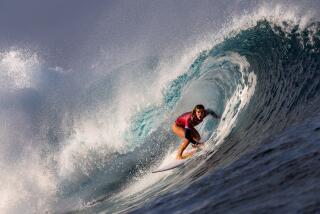Reaching Surfingâs Major League Gets a Little Easier
Gabe Kling covered approximately 17,000 miles in 52 hours last month, traveling from the tsunami-ravaged Maldives in southern Asia to the sandy white beaches of Brazil, spending an uncomfortable night along the way at Los Angeles International Airport.
Kling, a 24-year-old from St. Augustine, Fla., was trying to stay ahead of the global competition in the annual marathon to qualify for the 44-man World Championship Tour, the major leagues of professional surfing.
The race has been all uphill for Americans in recent years. Only four rookies from the United States have made their debut on the WCT in the last five seasons, and the average age of the current 15-man U.S. contingent is approaching 29.
In an effort to streamline the qualifying process and counter burnout, the Assn. of Surfing Professionals, the international governing body for the sport, has tinkered with the World Qualifying Series format, giving surfers with the talent and determination a clearer shot at reaching the highest level.
Thus far, many of those taking advantage of the changes are young Americans.
âIt has definitely helped me out,â said Kling, who finished No. 88 on the WQS last season.
Kling is currently ranked No. 7 heading into one of the tourâs premier events, the Honda U.S. Open of Surfing in Huntington Beach.
The six-star contest, the highest-rated level in WQS surfing, officially begins Monday with the menâs round of 192 and concludes July 31. There will be trial heats Sunday for eight spots into the main draw. Junior competition begins today and ends Sunday.
Kling is the top-ranked American on the WQS and one of two in the top 16, who qualify at seasonâs end for the WCT, the more exclusive, lucrative and glamorous series that requires considerably less travel.
However, the arduous process of qualifying for the top tour has caused many top young professionals, especially those from the U.S. mainland, to seek other opportunities. Their proximity to the wealth of video production companies and publications has made it easier to make a living modeling their craft at exotic locations without making a name for themselves on tour.
The changes to the qualifying format, which former ASP president Al Hunt described as âself-perpetuating,â could reverse that trend. âIt was too easy for the WCT guys to re-qualify,â Hunt said. Which meant new faces on the WCT were rare.
The ASP eliminated the handful of rounds that previously separated the lowest-seeded surfers from the scoring rounds, where competitors begin earning prize money and, more important, valuable points toward improving their rankings.
Up-and-coming surfers no longer had to stay alive through five or six heats for a chance to earn points toward a higher seeding and improved starting positions at future contests. The ASP managed to eliminate those rounds and avoid hacking a big portion of the fields by increasing the number of early-round heats from 16 to 24.
âItâs finally giving us younger surfers, who are just coming on tour, more of a fair chance,â said Alex Gray, 19, of Palos Verdes, who in his first full season on the WQS has shot up the rankings to No. 60.
Gray and Brett Simpson, a 20-year-old from Huntington Beach, produced the best results of their young careers last month, tying for third at the five-star event in Bahia.
The 1,460 points he earned lifted Simpson, ranked No. 174 a year ago, to No. 97 heading into the U.S. Open.
âSurfing a lot of heats, it wears you down,â said Simpson, who grew up in Garden Grove. âIâd rather surf quality heats instead of quantity.â
The ASP added another wrinkle that particularly aids those shooting up the rankings this season.
After the Maldives event, the ASP began seeding WQS events based on the competitorsâ performance this season, rather than how they finished in 2004. That allowed Kling to earn an automatic starting berth into the round of 96 at the U.S. Open, and Gray and Simpson to be awarded wild-card berths into the same round, giving them a shorter path into the scoring rounds.
The ASP has made other changes that seem to motivate up-and-coming talent.
Contests have been further restricted to include only the top 192 competitors and, beginning this season, the 30 who finished just outside the top 192 at the end of the previous season will replace the top 30 from just within the top 192 at the midway point, which was the last event in Durban, South Africa. Officials hope the shuffle will keep those near the cutoff line motivated.
âItâs a lot more cutthroat now,â Gray said.
But not everyone has benefited from the rule changes. One loser has been the WCT surfers, permitted to compete in WQS events and build qualifying points on that tour as a safety net in case they donât re-qualify by finishing among the top 27 on the WCT. They continue to receive the top seedings in WQS contests, but instead of beginning in the round of 64, they must start in the round of 96.
More to Read
Go beyond the scoreboard
Get the latest on L.A.'s teams in the daily Sports Report newsletter.
You may occasionally receive promotional content from the Los Angeles Times.










